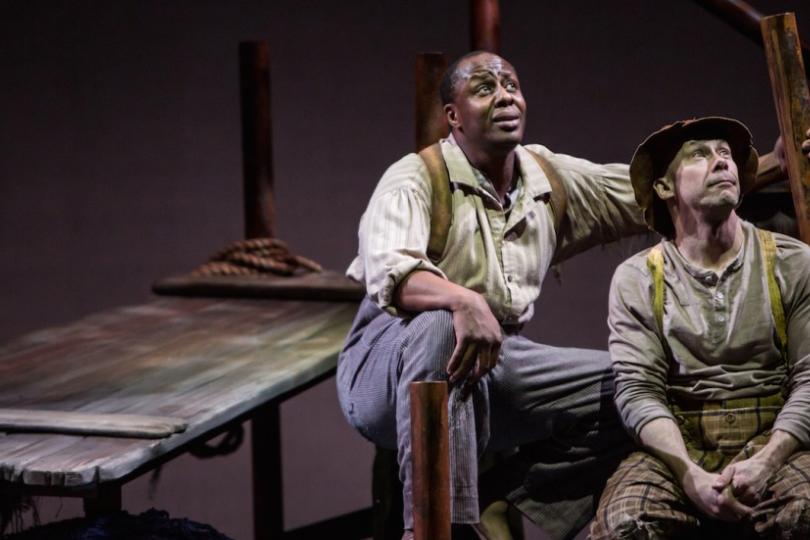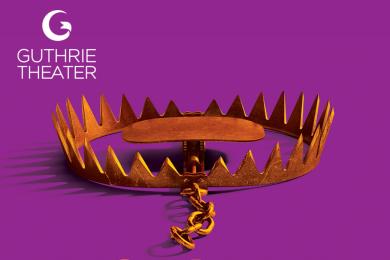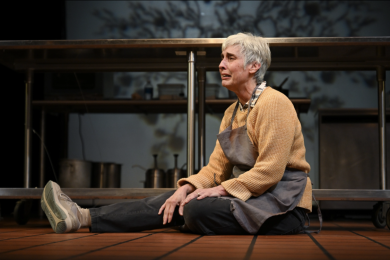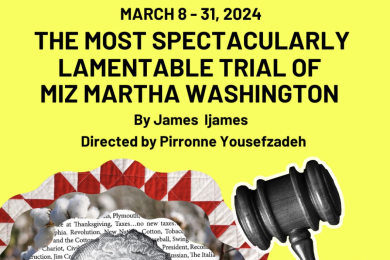Continuing the conversation about race

Director Greg Banks tackles incredible obstacles with personality and care in his staging of Huck Finn at Children’s Theatre Company. Wrestling with the immense challenges of adapting an iconic novel, of dancing around the violence and guilt of slavery as a long-lasting institution, and of translating these complex legacies for children in 80 minutes with no intermission--Banks has hurdled these obstacles in stride.
And let’s face it, those are a lot of obstacles.
The World on Stage
A gorgeous configuration of wooden planks, ladders, and stumps dominates the stage--appealing equally to the childlike playfulness of performers and to the actual 6-12 year olds squirming in seats throughout the theater. Victor Zupanc and Joe Cruz trod onto stage, yanking the audience into the folk and blues landscape of the Mississippi, complete with mandolin, banjo, guitar, fiddle, and a host of other instruments. Paul Whitaker’s bold lighting design evokes the richness of this landscape, the thickness of the summer air, and the heart of adventure driving these characters.
At its core, this Huck Finn exposes the boyish charm and cheery brattiness of child rebel, Huck, to a new crop of impressionable Twin Cities youngsters. At 14, Huck has already wrestled with the world--and this production highlights his eager appetite for more. Fleeing an abusive alcoholic father, Huck encounters Jim, an old widow’s slave, on the run. The two take to the Mississippi River, each escaping very different nightmares toward the elusive promise of freedom. Ultimately, Huck wrestles with his understandings of friendship and race, eventually “rescuing” Jim from slavery with childlike, single-minded determination.
Dean Holt’s Huck jogs onstage, fluidly springs onto the set, and then smartly plops onto his back. Impish delight on his face and mischief in his eyes, Huck tosses his straw hat onto his foot, then the dock, another stump, and finally onto an older woman sleeping on a dock. Holt’s light-footed scampering, his high-energy performance, and his judgment-free rendering of this young troublemaker convince the audience immediately that Huck would be a fun if impossible friend.
Populating the rest of this world are performers Reed Sigmund and Ansa Akyea, who transform into a slate of vibrant, terrifying, and charming characters. Sigmund shifts forms with strong vocal and physical choices--as charismatic and danger-courting Tom Sawyer, as Huck’s rageful alcoholic father, and as matter-of-fact Judith Loftus. Ansa Akyea undertakes several roles here too, but really shines as Jim, the sharp counterpoint to Huck’s biological father. As Jim, Akyea exudes deep care and hard-bought wisdom, brushed with a longing for friendship, family, and freedom.
The World of Words and Images
While every American has different experiences with racism and the weight of the legacy of slavery--deeply affected by socioeconomic status, racial and ethnic backgrounds, geographic location and migration, education, and a host of other factors--a book like Huck Finn provides an entry point for some into this confusing world of power and privilege.
After all, Huck’s story is both his own and also a reflection of larger cultural narratives. Huck’s father reminds us that biological parents do not always have their children’s best interests at heart, that fear breeds hatred, and that violence stunts kids. Tom Sawyer here reminds us that sometimes in prioritizing our own sense of adventure and fun, we co-opt and trivialize the experiences of others.
As this is Huck’s show, we hear the worldviews he was taught--and hopefully interrogate to what extent these assumptions persist within ourselves. When hearing of a reward for catching Jim, Huck exclaims: “Such a big stack of money, I bet [the old widow] couldn’t resist!” For this young, poor, white boy during this time, the appeal of money would probably override any potential distaste for commodifying Black bodies. Do we blame him for these values? For being poor? Or do we ask about the roots of his poverty and what it means to be poor and white in this context?
As Twain offers more voice to Jim over time, Huck begins to question his inherited values. After Huck tricks Jim yet another time, Jim acknowledges his hurt and responds with deep affection: “My heart was almost broke because you was lost…[when you returned] the tears came down [and] I could have kissed your foot--but all you could think about was how to trick old Jim.” A pause. “I wouldn’t have done that if I’d’ve known it would make him feel that way,” Huck notes with a shrug.
Later, Jim openly dreams of freedom--not for himself, but his family: “I’m gonna buy back my wife, I’ll go buy back my two kids…” Overhearing his words, Huck realizes: “I do believe he cares as much for his people as white people do for theirs.”
In the end, Huck thinks he helps Jim because Huck is “wicked”: his actions so defy the slavery-rationalizing messages he had ingested that he can only embrace himself as a lost cause. “I’ll go to the fires of hell! I’ll steal Jim back out of slavery!” he declares with mischief--and is that justice?--in his eyes.
Why do these moments matter? Because these questions about morality and justice, these images of dehumanization and powerlessness, these narratives of inequality and racism persist today. And modeling defiance of injustice for kids is important, exhausting, emboldening work.
But before modeling defiance for others, a show like this asks us: How confident are we in tackling these issues within our own lives first?
The World We Live In
On their website, CTC features comments from actor Ansa Akyea that so moved me I want to repeat them exactly as he wrote them here:
Aside from the opportunity to work with such a stellar group of collaborators, I am doing this story for my children. I'm doing this play for them to see and understand the challenges of the world they are coming into; a world of inequality based on race, a world filled with demands on humanity based on profit and money, and a world where being yourself can be the purest, most dangerous and political act you can make. I am doing this piece because it captures Mark Twain's American literary genius in reflecting man's capacity for cruelty in the institution of slavery, man's ability to love beyond skin color, and the importance of family beyond definition, country, and freedom. I wanted to do this production again because CTC has the theatrical acumen and the artistic ethics to challenge and tackle a difficult part of American history, a history that we are still struggling to confront. This story inspires us to raise the bar on imagination, to unlock limitations of thought and action, and it reminds us that we are capable of anything, good and bad, but we have the power and grace to change our circumstance regardless. This is the gift that I give my son and my daughter in performing this piece again at CTC and this is the reason why I am doing this production of Huck Finn.
Granted, most of these conversations will happen long after kids bounce out of the theater.
Hopefully these conversations about racism and cruelty, of fear and ignorance, of resistance and justness will occur in pockets of normalcy: while waiting for school buses, buckling seatbelts, or brushing teeth. And as uncomfortable or depleting or unfamiliar as these conversations may be, they are unquestioningly necessary—for kids, certainly, but also for ourselves.




